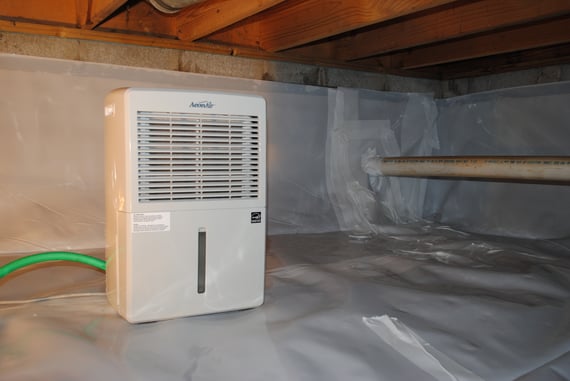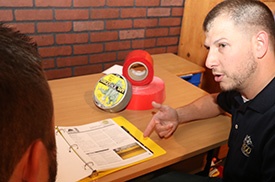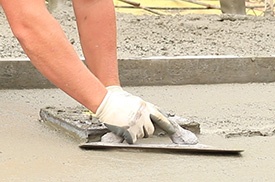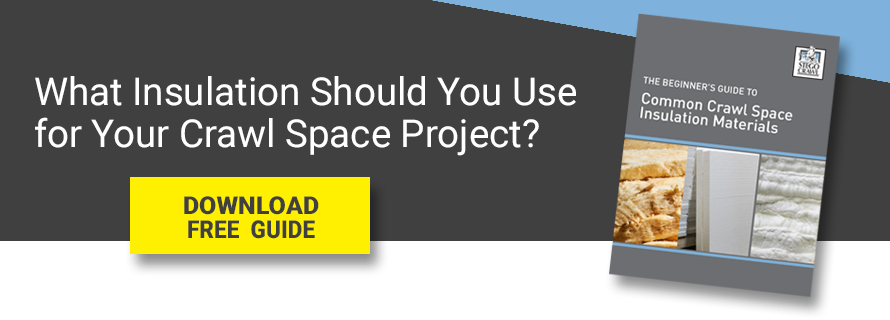5 Best Practices to Make Your Crawl Space and Home Energy Efficient

To maximize energy efficiency at home, houses with crawl spaces should insulate, seal, and dehumidify this often neglected space. | Image Source: Stego® Industries, LLC
When homeowners want to prevent energy loss and reduce utility costs, they’re apt to replace drafty windows and doors or insulate walls and ceilings, but the crawl space may not immediately come to mind. Compared to the rest of the house, the crawl space is seldom seen, rarely used, and often neglected. And that neglect is a shame, because your crawl space is actually quite crucial to the overall energy efficiency of your home.
The EPA’s Energy Star® program reports that crawl spaces and basements are one of the best opportunities to save energy in a home — this is especially true if you live in a hot or cold climate, where homes are the most prone to feel the effects of energy loss from an inefficient crawl space. During the colder months, drafts of cold air will lower the overall temperature of your house, and in the warmer months, heat can collect in the crawl space and cause a home to lose any cold air that’s generated from within.
Just as it’s important to ensure that moisture doesn't enter the crawl space, it’s also necessary to prevent unwanted air and drafts from causing energy loss. Luckily, there are a number of ways to make your crawl space more efficient and help maintain its condition for years to come, and I want to talk about five of them today.
#1: Insulate the Access Door to the Crawl Space
Similar to any other door in your house that connects to the outside, it's important to keep the crawl space access door insulated. Whether this door enters directly into the house or is accessible from the outside, it should be airtight at all access points. This regulates the air temperature in the crawl space, which helps maintain a better climate throughout the house.
While it’s possible to purchase custom made doors for this space, make-shift doors using plywood or a similar material are often used. For homes using a plywood access door, it's recommended to cover the inside of the door with a firm insulation board to provide some much needed R-value (the measure of the resistance to the flow of heat). A standard exterior door in today’s market will have an R-value rating that ranges from R-5 to R-6, so an insulation board with this same range is recommended. Weather stripping can also be added along the outside edges to help keep out drafts.
#2: Insulate and Seal Ducts
Homes with crawl spaces will most likely have air ducts and plumbing pipes running between the joists; as the ducts are connected to the air system in the house above, it's crucial they don’t have any holes or leaks. A duct with a hole can lead to two things, both of which are bad for the overall efficiency of the crawl space and the house:
- Air generated within the house for cooling or heating purposes will escape into the crawl space, or
- Unwanted hot or cold air from within the crawl space can spread up into the house.
Any holes or leaks in air ducts can be easily addressed by applying a mastic tape or similar. While duct tape may also seem to fit the part, this type of tape is actually not long-lasting for this application. When sealing the ducts, all connection points into walls or floors should also be inspected, and all seams should be sealed properly to increase efficiency.
There are also various insulation duct wraps available depending on the type of duct found in the crawl space. Most of these will be composed of fiberglass covered with a protective foil to prevent mold or condensation from forming. Building codes will also require specific types of duct insulation based on R-value, so it’s recommended to know the codes for your residential area. This extra layer of insulation will make a big impact on energy efficiency, preventing the ducts from losing their preferred temperature.
#3: Remove Insulation from Floor Joists and Plug Any Holes
If there’s already spray foam insulation between the floor joists, it may not be worth the time and effort to remove it. When installed correctly, spray foam insulation will not allow mold to grow beneath it, and the material itself does not support mold growth. Spray foam is messy and time-consuming to remove, so as long as it’s properly installed, it’s best to just leave it in place between the joists.
Otherwise, you should remove the insulation from the joists, because it will be much easier to inspect the floor between the joists for holes or gaps. It’s particularly worth checking anywhere that wiring or piping may be running up into the house above. It’s recommended to fill any such holes with an insulation that won’t support mold growth — a quick and easy solution for plugging these holes is to use an expanding spray foam insulation.
#4: Insulate the Perimeter of the Walls
Rather than insulating between the joists, it’s much more energy efficient to insulate the perimeter of the crawl space with a foam insulation board. With insulation on the walls of the crawl space, the entire space can now better regulate and maintain an ideal air temperature, preventing the crawl space from getting either too hot or too cold. Foam insulation board material will not support mold or allow unwanted air from the outside to pass through, which can damage the various pipes and ducts in the crawl space. The other benefit of this method is that contractors needing to access pipes or ducts between the floor joists will not have to deal with removing insulation in order to do their work. It’s also a good idea to add insulation around the perimeter of the crawl space, assuming that it does not have open vents and there is adequate vapor barrier on the ground and vertical wall.
#5: Use a Dehumidifier to Control Climate
Lastly, when it comes to making a crawl space energy efficient, the air within the space should be controlled with a dehumidifier unit. There are several different types of dehumidifiers available for crawl spaces, so it’s best to do diligent research and choose the one best for your space. Keep in mind the temperatures in your location and the size of your crawl space. Installing a dehumidifier will ensure the air within the space does not reach extremes and stays at a constant, comfortable temperature. This unit will also help manage the moisture and prevent any mold or mildew from growing on any of the surfaces, including the insulation. A thermostat can trigger when the system is needed to kick on so it’s not running at all times and wasting energy.
Preventing air drafts and the passage of air from the crawl space into the house will go a long way to cut costs and reduce wasted energy, and taking these five practices into account can help any home with a crawl space be more energy efficient. Not sure if your crawl space needs an upgrading? Take a look at the EPA’s Energy Star® website to learn some tips on testing your crawl space and to learn more about other ways to make it more energy efficient.

Written by Tom Marks
Tom Marks is the Business Development Project Manager with Stego Industries, LLC. He has been with Stego since 2007, serving many years as the Rocky Mountains Regional Manager. Now, his focus is geared toward vapor barrier solutions for new and existing homes as the Product Manager of the StegoHome and StegoCrawl brands. In addition, Tom serves as Sustainability Manager, overseeing Stego’s leadership in holistic product and corporate sustainability. Tom enjoys working with a wide range of project team members and customers to incorporate effective sub-slab vapor protection and create healthy, sustainable homes and buildings.
- Stego (26)
- StegoCrawl (24)
- Stego-Awareness (17)
- Case Studies (14)
- StegoCrawl-Consideration (12)
- StegoCrawl-Awareness (11)
- StegoHome (10)
- Customer Stories (9)
- Stego-Consideration (9)
- Pango (8)
- Beast (7)
- StegoHome-Awareness (6)
- How to Install (5)
- Pango-Awareness (5)
- Beast-Awareness (4)
- Drago (4)
- StegoHome-Consideration (4)
- Beast-Consideration (3)
- Pango-Consideration (3)
- Stego IQ (3)
- Drago-Awareness (2)
- Drago-Consideration (2)
- StegoCrawl-Decision (2)
Popular Posts
Stay Connected.
Enter your email below.











Post Comments